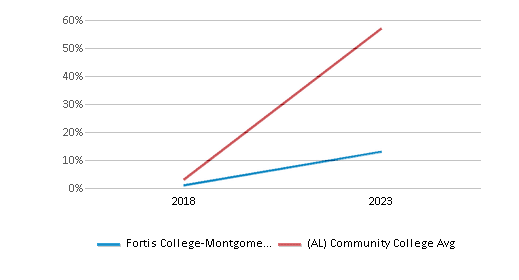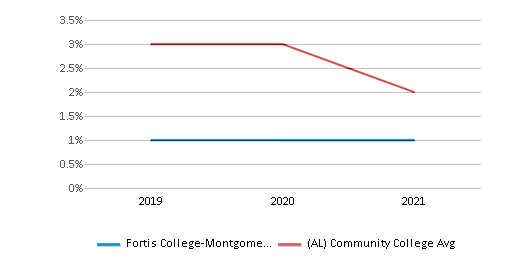School Highlights
Fortis College-Montgomery serves 425 students (100% of students are full-time).
The college's student:teacher ratio of 16:1 is lower than the state community college average of 20:1.
Minority enrollment is 94% of the student body (majority Black), which is more than the state average of 43%.
Quick Stats (2025)
- Enrollment: 425 students
- Private-state tuition: $20,579
- Student:teacher ratio: 16:1
- Minority enrollment: 94%
- Source: Integrated Postsecondary Education Data System (IPEDS)
Top Rankings
Fortis College-Montgomery ranks among the top 20% of public schools in Alabama for:
Category
Attribute
Completion Rates
Debt For Students
School Overview
The teacher population of 26 teachers has stayed relatively flat over five years.
Fortis College-Montgomery
(AL) Community College Avg.
Carnegie Classification
Not applicable, not in Carnegie universe (not accredited or nondegree-granting)
Associate's Colleges: Mixed Transfer/Career & Technical-High Traditional
Institution Level
Less than 2 years (below associate)
At least 2 but less than 4 years
Institution Control
Private for-profit
Public
Total Faculty
26 staff
153 staff

Number of Programs Offered
4
5
Student Body
The student population of Fortis College-Montgomery has grown by 24% over five years.
The student:teacher ratio of 16:1 has increased from 11:1 over five years.
The Fortis College-Montgomery diversity score of 0.48 is less than the state average of 0.60. The school's diversity has grown by 64% over five years.
Total Enrollment
425 students
2,464 students

Student : Teacher Ratio
16:1
20:1

# Full-Time Students
425 students
873 students

# Part-Time Students
85 students
1,855 students



# Enrollment Undergraduate
425 students
422 students
# Full-Time Undergraduate Students
425 students
873 students

# Full-Time Graduate Students
n/a
11 students
# Part-Time Undergraduate Students
85 students
2,077 students
# Part-Time Graduate Students
n/a
30 students
Total Dormitory Capacity
n/a
168 students
% American Indian/Alaskan
n/a
n/a

% Asian
16%
2%

% Hispanic
3%
6%

% Black
70%
27%

% White
6%
57%

% Hawaiian
2%
n/a

% Two or more races
2%
4%

% Non Resident races
n/a
1%
% Unknown races
n/a
3%


Diversity Score
0.48
0.60

College Completion Rate (Students who graduate in less than 4 years)
0.503%
0.2683%

College Completion Rate (Students who graduate in 4 years or more than 4 years)
n/a
0.3%
Average Graduate Earnings (10 Years)
$21,900
$29,700

Tuition and Acceptance Rate
The private state tuition of $20,579 is more than the state average of $13,954. The private state tuition has grown by 48% over four years.
Private State Tuition Fees
$20,579
$13,954

% Students Receiving Some Financial Aid
85%
90%

Median Debt for Graduates
$9,500
$10,500

Median Debt for Dropouts
$5,236
$5,500

Acceptance Rate
n/a
81%
SAT Reading
n/a
530
SAT Math
n/a
545
ACT Composite
n/a
23
ACT English
n/a
21
ACT Math
n/a
22
Source: 2024 (or latest year available) Integrated Postsecondary Education Data System (IPEDS)
Frequently Asked Questions
How much does Fortis College-Montgomery cost?
Fortis College-Montgomery's private state tuition is approximately $20,579.
What is Fortis College-Montgomery's ranking?
Fortis College-Montgomery ranks among the top 20% of community college in Alabama for: Average community college minority breakdown, Highest completion rates and Least debt for graduating students.
Recent Articles

Obtaining Your Bachelor's Degree at a Community College
Explore the evolving landscape of community colleges offering bachelor's degrees, addressing affordability, accessibility, and workforce needs.

A to Z of Community College Certificates and Courses
From business and healthcare to technology and skilled trades, the article showcases the breadth of options available to students seeking to enhance their knowledge, develop new skills, or pursue career advancement.

What is a Community College?
This comprehensive guide explains what a community college is, its history, and its role in higher education. It covers the types of programs offered, differences from four-year colleges, benefits of attending, and important considerations for prospective students, providing valuable insights for those exploring educational options.

![Making Money With WriteAppReviews 👉 ► http://bit.ly/writeappreviewforstudent Is A Simple 3 Step Process For Fortis College Montgomery West StudentFortis - Montgomery West is a for-profit college located in Montgomery, Alabama. It is a small institution with an enrollment of 337 undergraduate students. The Fortis - Montgomery West acceptance rate is 100%. Popular majors include Medical Assistant, HVAC and Refrigeration Engineering Technician, and Dental Assisting. Graduating 45% of students, Fortis - Montgomery West alumni go on to earn a starting salary of $17,200.waisted time...1 person handles everything!...they claim to be who their not...their just in it for the money...more students more money...your typical corporate AmericaThe quality is awesome they help you every step of the way. Making sure your job and degree plan fits you and also walk with you hand in hand on finding the right job for you. They are the most supportive and helpful administrators ever.They have thier own lab and website for research. Learn.com is what they use and it gives accurate information on what students are researching. Printing is no problem, I like the fact that they do not charge to print things, and students are able to use the lab at anytime.#FortisCollegeMontgomeryWest #FortisCollegeMontgomeryWestreview #FortisCollegeMontgomeryWestunitedstates fortis college montgomery west review DoNotGoTo[FortisCollegeMontgomeryWest]BeforeUWatch this video|Fortis College Montgomery west Review](https://i.ytimg.com/vi/qp9-LreJ5zo/0.jpg)




